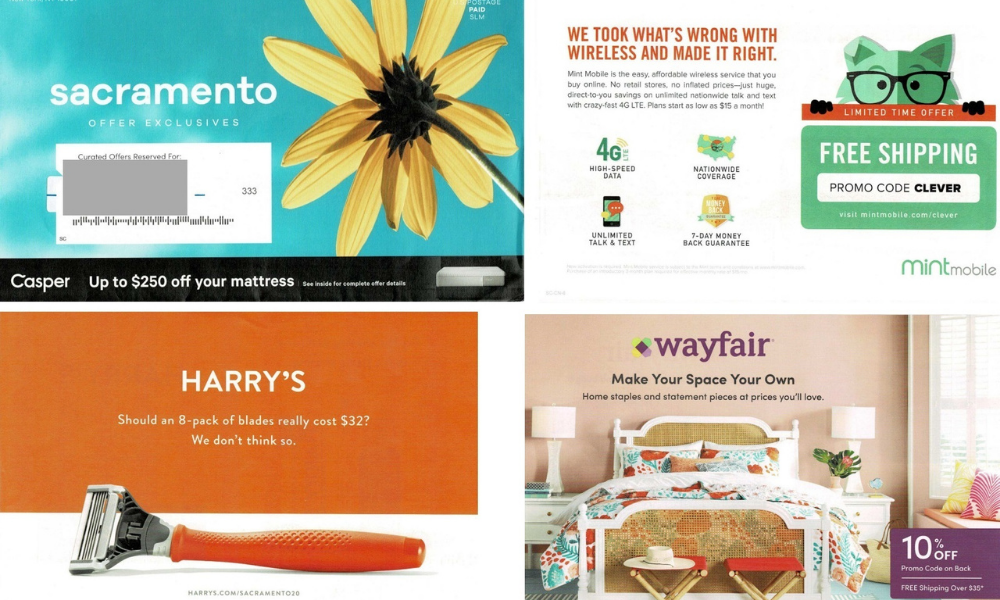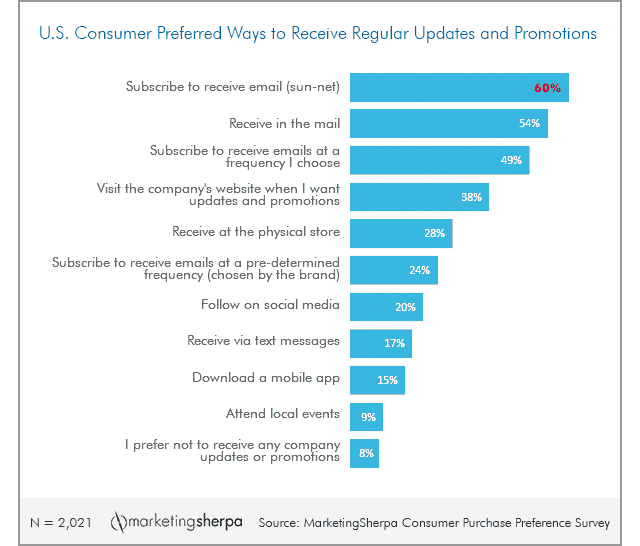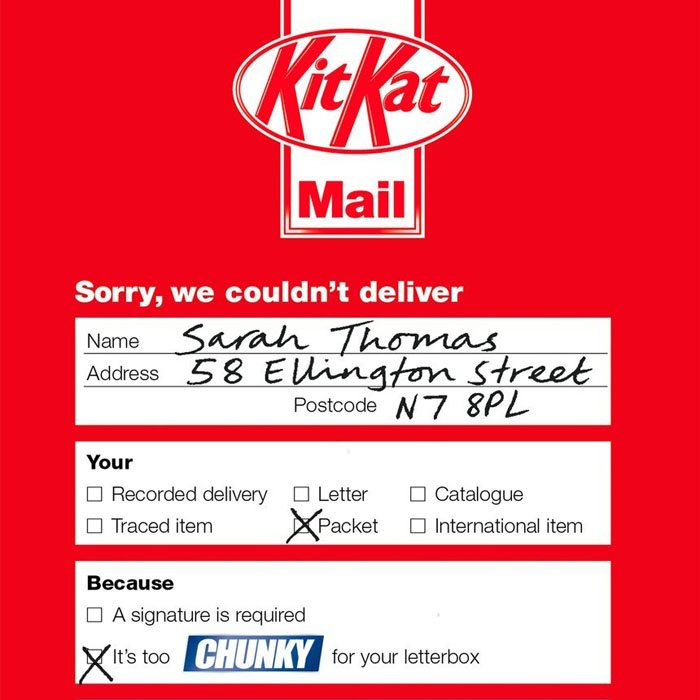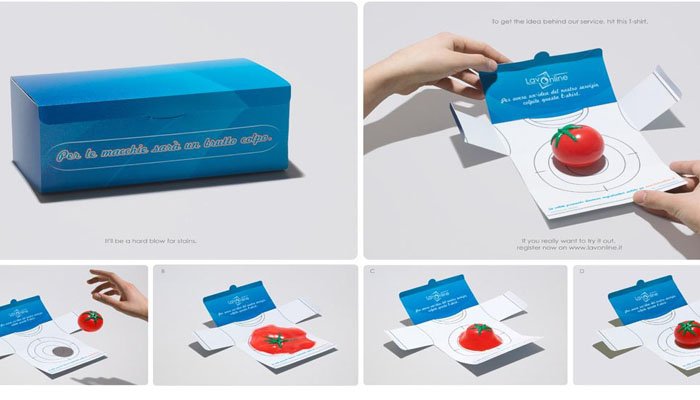Although email and SMS marketing campaigns make it easy to reach potential customers in a flash, there is still a benefit to including direct mail marketing as part of an omnichannel strategy. It’s an affordable way to reach potential customers in their homes and serves as a cost-effective alternative to digital outreach, which is becoming more expensive. Consumers still read direct mail, with 68% of millennials stating that they’ve read physical mailers from retailers. Therefore, this tried-and-true advertising channel is a must for retailers.
Table of Contents
- > What Is Direct Mail Marketing?
- > Direct Mail Marketing Metrics and KPIs
- > Advantages and Disadvantages of Direct Mail Marketing
- > Direct Mail Marketing Benefits and Effectiveness for Retailers
- > Planning Your Direct Mail Campaign: A Step-by-Step Guide on Planning a Successful Direct Mail Campaign in Retail
- > Best Practices for Direct Mail Marketing in Retail
- > 6 Mistakes to Avoid in Direct Mail Marketing
- > ContactPigeon Already Empowers Top-Notch Retailers With Direct Mail
- > Unlocking the Potential of Direct Mail Marketing in Retail
What is direct mail marketing?
Direct mail marketing refers to physical messages a business sends to its customers through the mail. For retailers, direct mail typically includes coupons and other promotional materials. Direct mail gives the ability to retailers to send targeted messages that are noticeable and effective.
With direct mail, customers have a physical coupon or promotional offer that serves as a reminder to visit the store. It’s also an easier way to reach customers in the age of ad blocking and stricter rules governing how companies can collect personal data to target internet browsers.
The different types of direct mail
Many retailers prefer sending postcards because they’re cost-effective and easy to personalize with design elements. However, direct mail for retailers might also include catalogs, offer letters, and even eye-catching dimensional mailers that stand out from traditional mail and surprise potential customers.
How direct mail integrates with other marketing channels
Direct mail may be effective on its own, with a 90% open rate, but this strategy is even more effective when included as part of an omnichannel marketing strategy. An omnichannel strategy lets retailers guide customers through their buyer’s journey, offering seamless messaging and a tailored approach.
As part of this approach, retailers can leverage their digital media to launch targeted direct mail marketing campaigns for various goals. They can reach out to their most loyal customers with exclusive offers and discounts and create awareness campaigns to target new potential customers in the area. Direct response advertising in retail can effectively supplement social media campaigns, email marketing, and more.
The different types of direct mail

Many retailers prefer sending postcards because they’re cost-effective and easy to personalize with design elements. However, for retailers, direct mail might also include catalogs, offer letters, and even eye-catching dimensional mailers that stand out from traditional mail and surprise potential customers.
How direct mail integrates with other marketing channels
Direct mail may be effective on its own, with a 90% open rate, but this strategy is even more effective when included as part of an omnichannel marketing strategy. An omnichannel strategy lets retailers guide customers through their buyer’s journey, offering seamless messaging and a tailored approach.
As part of this approach, retailers can leverage their digital media to launch targeted direct mail marketing campaigns for various goals. They can reach out to their most loyal customers with exclusive offers and discounts and create awareness campaigns to target new potential customers in the area. Direct response advertising in retail can effectively supplement social media campaigns, email marketing, and more.
Direct mail marketing metrics and KPIs
Retailers can track and measure key performance indicators (KPIs) and compare them to past and future campaigns For better success with direct mail marketing campaigns. These are the most crucial direct mail marketing KPIs to measure.
Response rate
Use this metric to determine how many people responded to an offer. In 2022, the average letter-size envelope campaign had a return on investment of 112%. The average direct mail response rate across industries is about 2% to 4%. When mailing an offer, use a unique coupon code or have customers redeem physical coupons to track responses.
Conversion rate
The conversion rate refers to how many people became customers following a direct mail campaign. This number would include anyone who made a second purchase after redeeming their initial offer. As in the response rate metric, this number will likely be less than 10%.
Customer lifetime value

Customer lifetime value refers to the total amount of money a customer spends with a retailer. Some people who respond to a direct mail marketing campaign may shop with a retailer only once, offering a low customer lifetime value. However, direct mail is a great way to improve the average customer’s lifetime value by providing discounts and other perks to frequent shoppers.
Cost per response
Retailers can track their cost per response to see how effectively they spend their marketing dollars. Calculate this metric by dividing the total cost of the campaign by the number of overall responses. For example, if a retailer paid 75 cents a piece to mail 10,000 postcards, the total amount spent for that campaign would be $7,500. A response rate of 4% would result in 400 responses, which would be $18.75 per response.
Mailing quantity
Mailing quantity refers to the total number of direct mailers sent per campaign. This metric is essential for calculating others, including response rate, conversion rate, and cost per response. Although a retailer can choose to mail the same number of offers for each campaign, it is more likely that this number will shift based on the company’s goals.
Advantages and disadvantages of direct mail marketing
Like any advertising channel, direct mail marketing has its advantages and disadvantages.
The advantages of direct mail marketing

Direct mail marketing is a tried-and-true strategy that has worked for multiple retailers for over a century. It offers the following advantages.
Tangibility and memorability
A direct mail marketing campaign gives customers something with physical substance so they can see and feel it, keeping the retailer at the top of their minds. It may also motivate them to check out a new store that otherwise they may not have even considered.
Targeting capabilities: Direct mail marketing can reach more than one customer at a time
Because direct mail campaigns can reach the entire household as opposed to a private email address, there is the potential to target more than one customer with each campaign. Potential shoppers may cut the coupon and put it in their kitchen, allowing others in the household to see the ad. With these campaigns, retailers can also reach new residents in an area.
When an email bounces, no customers are exposed to the offer at all. However, even when the intended recipient of physical mail moves, the post office may still deliver the mail to their old address for a period of time, reaching new customers even at an incorrect address.
Brand recognition
Direct mail marketing helps small businesses boost their brand recognition. When used in conjunction with other marketing channels, direct mail helps smaller businesses run successful campaigns. With QR codes, promo codes, and other tracking tools, a small business can also effectively track each campaign’s success rate.
Personalization
Today’s customer responds to personalization. Direct mail marketing services allow small businesses to reach out to people in their area with tailored messaging based on buying history, demographics, and more. Printing practices and mail-merge software even allow businesses to directly address customers with mail.
Creativity

Because direct mail is a physical medium, retailers can get creative with their mailers. They can even send three-dimensional mailers with pop-ups and other features that make a difference and stand out to potential customers.
The disadvantages of direct mail marketing
Direct mail advertising does have its disadvantages, however. Consider the following before using direct mail.
Implementation cost
With shipping costs rising substantially during the pandemic, direct mail is more expensive to implement than its digital counterparts. Direct mail costs an average of $0.30 to $3.00, with heavier pieces such as catalogs costing more.
Production time
On average, it takes five to 10 weeks for a business to design and implement a direct mail campaign. Retailers need time to sort their mailing list, plan the offer, design the creative material, and produce each piece of direct mail.
Results that are harder to measure
Retailers can take steps to track results, as mentioned earlier, but there is no guarantee that customers will use these tools when taking advantage of an offer. Additionally, a customer might receive a coupon, allow it to expire, and then decide to make a purchase later on anyway. In this case, the direct mailer would have been successful, but there is no way to measure it.
Sustainability issues
Current customers care about sustainability and may see direct mail as a sign that a business is not committed to environmental responsibility. It’s critical to make sure these mailers are recyclable.
Direct mail marketing benefits and effectiveness for retailers
The majority of marketers believe that direct mail is one of their most successful marketing channels in terms of conversion rates and return on investment. Here is a breakdown of how well it works for most retailers.
Key trends and statistics for direct mail marketing
Direct mail marketing has proved to facilitate high engagement rates, an excellent return on investment, and great conversion rates. As customers experience email fatigue and concerns about their privacy, they are in a prime position for targeting with direct mail.

Direct mail marketing statistics you should not miss in 2023
- 58% of marketers allocated more of their advertising budget to direct mail in 2022, which may continue into 2023 (Lob).
- 74% of marketers state that direct mail has the best ROI (Lob).
- 71% of consumers consider direct mail advertising to be more personal (Postalytics).
- 66% of marketers use postcards for direct mail (Postalytics).
- Businesses sent 200,000-plus more postcards in 2022 than in previous years (PostcardMania).
The latest trends for direct mail marketing in retail
- The U.S. Postal Service is offering discounts on innovative mail in 2023 (Mailing.com).
- Companies use variable data printing to personalize their mail campaigns (Mailing.com).
- More companies use data to target potential customers (Mailing Systems Technology).
- Companies are experimenting with triggered mailers (Mailing Systems Technology).
- Retailers use direct mail to improve their response rates for other advertising channels (Brumley Printing).

Planning your direct mail campaign: A step-by-Step guide on planning a successful direct mail campaign in retail
Like any other marketing strategy, direct mail campaigns are more effective with proper planning. Take these steps to improve yours.
1. Defining campaign objectives and target audience
Before copywriting and design work, retailers should define their goals and set a target audience for each campaign. What works for getting established customers to take advantage of an offer may not be appropriate for building brand awareness and attracting new business.
2. Crafting compelling offers and messaging
Once a retailer has solidified its goals and target audience, it’s time to decide on the offer. Do some market research at the start of each direct mail marketing campaign to learn what types of offers and messages resonate with your target audience. Each direct mailer should include a call to action spurring recipients to take advantage of the offer.
3. Designing visually appealing pieces of mail
Make each mailer stand out with bold colors and a stunning design. Although consumers receive fewer direct mail messages than emails, it’s still important to stand out from everything else in the mailbox. Start with the size of each piece and use these dimensions to guide your choices for fonts, graphics, and other design elements.
Smaller mailers may be more cost-effective, but they require creativity to be effective.
4. Segmenting and personalizing your mailing list
Breaking down a mailing list into smaller parts allows marketers to create messaging for each segment. With this tactic, they can pair the right messages with their recipients for better impact. Create segments based on factors such as demographics, geographic location, and length of time as a customer.
5. Setting a budget and timeline
With all the details in place, a retailer can start considering the budget. The goals and objectives for the campaign, its size, and its potential reach will influence the overall cost. Setting a budget and timeline helps guide campaign specifics such as how many pieces will be mailed and what kind of creative material will be most feasible. Specialty pieces are more expensive to mail, so be strategic with your options.
6. Integrating direct mail with other marketing channels
If a retailer’s direct mail campaign is just a part of an overall campaign, the language should be consistent across all channels. The retailer may also consider adding a call to action to the direct mail, guiding recipients to a website or social media page.
Best practices for direct mail marketing in retail
For direct mail to be effective, each campaign should be memorable. Follow these tips to improve your chances of success.
Create attention-grabbing headlines and compelling copy
Like in email marketing, the direct mail marketing metrics can be improved with a strategic copy. Create headlines that entice readers to investigate the offer. Use actionable language urging recipients to take advantage of each promotion. With direct mail, short sentences, and stunning visuals are often more effective.
Design eye-catching visuals and layouts

Effective imagery, graphics, fonts, and layouts will improve each direct mail campaign. The visuals and graphics should direct the reader to the offer. Guide the reader through the message with headlines, subheaders, and negative space.
Always include a CTA
A pretty piece of mail is nothing without an effective call to action. Make sure to include language that spurs the reader to take a specific action, such as using a coupon or signing up for more information on the company’s website. Make sure the CTA is highly visible as well.
Personalize and segment your mailers
Use language that resonates with the specific target audience. Take advantage of software and printing practices to add names to each message for a more personal touch. Finally, take advantage of segmented mailing lists to pair the right mailers with the right demographics.
Test and optimize every campaign

Retailers can use A/B testing with direct mail just like they can with other marketing channels. Create two versions of a campaign and send them out to small target audiences to assess which message is most effective. Use the lessons you learn from each campaign to optimize your future campaigns.
Track and measure campaign performance
With QR codes, tracking numbers, and specific landing pages, a retailer can more effectively track the ROI of each direct mail marketing campaign. Use these tools and analytics reports to determine which campaigns are the most successful.
Leverage data-driven insights for continuous improvement
By tracking campaign performance, retailers can make small changes with each successive campaign. Whether they refine their CTAs or change the design of each postcard to make it more appealing, each insight helps retailers improve their future campaigns.
6 mistakes to avoid in direct mail marketing
Avoiding these common mistakes can improve a retailer’s chances of boosting its direct mail ROI.
1. Neglecting to define clear objectives or a target audience
Clear goals and a target audience help guide the messaging and design for a direct mail campaign. Without it, there is no way to structure an impactful message. Throwing direct mailers into the world with no guidance will not yield the same results as a deliberate, carefully crafted campaign.
2. Failing to design compelling and visually appealing mail

Without an effective design, customers will be more likely to toss a piece of mail in the recycling bin without looking at it. Use standout headings and strong CTAs to capture recipients’ attention when they’re sifting through the mail.
3. Forgetting to drive traffic to the company’s website
Always add a link to the website in each direct mail advertising campaign. This way, potential customers who may not be close to a physical store can still take advantage of the offer, and customers who have never heard of the business can log on to learn more.
4. Overlooking the importance of personalization and segmentation
It’s possible to send out a direct mail campaign to the entire mailing list, but doing so may dilute the campaign’s effectiveness. By segmenting their mailing lists, retailers can target their audience with the words and phrases that are most likely to trigger the desired action.
5. Neglecting to track and measure campaign performance
Tracking campaign performance provides valuable insights into what’s working and what’s not. It also helps business owners benchmark their success against past efforts. Make sure to track each successive campaign to improve your future campaigns.
6. Ignoring customer feedback and insights
Existing customers are the best way to determine what will work for future customers. Use their feedback to tailor each direct mail campaign. For example, if a retailer finds out that customers like the easy checkout process on its website, it can highlight that feature in its next direct mail marketing campaign.
ContactPigeon already empowers top-notch retailers with direct mail postcards

We understand how direct mail can boost your current marketing efforts, and we can help you launch an effective direct mail postcard campaign. Our team works with retailers all over the world, helping them segment their lists and tailor their direct mail advertising campaigns to deliver the right message with personalized postcards. Instead of working with a direct mail advertising agency, trust us, because we know how each aspect of your omnichannel strategy works in unison.
Unlocking the potential of direct mail marketing in retail
With digital marketing costs rising and internet regulations changing the way retailers can use customer data to personalize their campaigns, direct mail marketing stands out as an effective tool in any retailer’s arsenal. Retailers can use direct mail to enhance their omnichannel success, building on successful strategies and personalizing each ad campaign.
If you’re interested in developing a successful direct mail campaign, follow the best practices outlined above. Or use ContactPigeon. We know retail inside and out, and we’re ready to help your eCommerce brand launch or improve its omnichannel marketing strategy. Contact us to learn more.
Book a free 30-minute retail customer engagement consultation with ContactPigeon’s experts and incorporate an omnichannel strategy that will boost customer engagement and growth for your business.

Let’s Help You Scale Up
Spending time on Linkedin? Follow us and get notified of our thought-leadership content:




![Benchmarking Growth Strategies of Top Fashion Retailers [Study]](https://blog.contactpigeon.com/wp-content/uploads/2025/11/top-fashion-retailers.jpg)